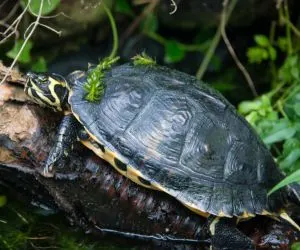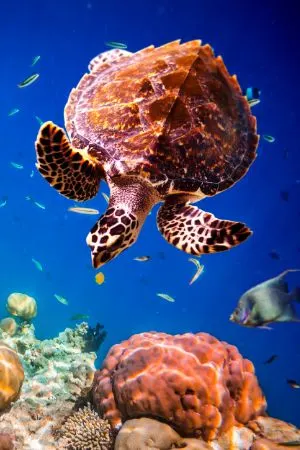There are 8 turtles in Hawaii, most of which are sea turtles. Sea turtles in general are a tourist attraction, with people from all over the country (and the world) coming here to swim with them or even just catch a glimpse of – one of the five sea turtles that call the Aloha State their home.
But sea turtles are not the only Testudine residents of Hawaii. There are also two types of softshells and pond sliders here.
Turtles in Hawaii
1. Pond Sliders

- Experience Level: Beginner
- Family: Emydidae
- Scientific Name: Trachemys scripta
- Other Names: red-eared sliders, yellow-bellied sliders, and Cumberland sliders (subspecies)
- Adult Size: 4-12 inches
- Lifespan: 20-50 years
- Average Price Range: $15-$50
Pond sliders are one of the most widespread turtle species in the US, and Hawaii is no exception. There are three subspecies of pond sliders: the red-eared slider, the yellow-bellied slider, and the Cumberland slider.
Among the three, red-eared sliders are the most common and most popular as pets. However, owners sometimes release adult red-eared sliders into the wild once they are no longer able to take care of them. This, paired with their invasive nature, is what has made them so widespread.
In Hawaii, pond sliders can be found on five of the major islands – Hawaii, Maui, Molokai, Oahu, and Kauai.
2. Chinese Softshell Turtle

- Experience Level: Intermediate
- Family: Trionychidae
- Scientific Name: Pelodiscus sinensis
- Other Names: Asiatic softshell turtle, dwarf softshell turtle
- Adult Size: 11-13 inches
- Lifespan: 25 years
The Chinese softshell turtle is, as you probably guessed, native to Asia. It made its way to Hawaii with Asian immigrants, who harvested them for food from the 1800s until World War II.
Today, Chinese softshell turtles are considered vulnerable by the IUCN, and their population keeps declining. There are countless specimens being bred for food, and that, unfortunately, doesn’t help their preservation in the wild.
The species is highly aquatic, even more than other similar types of turtles. They enjoy swimming and do it a lot, only occasionally venturing to dry land.
3. Wattle-Necked Softshell Turtle

- Experience Level:
- Family: Trionychidae
- Scientific Name: Palea steindachneri
- Other Names: Steindachner’s soft-shelled turtle
- Adult Size: 14-18 inches
- Lifespan: 40 years
Much like its above mentioned cousin, the wattle-necked softshell turtle is native to Asia and was most likely brought to Hawaii by Asian immigrants for food purposes. To this day, it is still heavily poached for food all around Asia.
Wattle-necked softshells prefer clear, running fresh water, such as mountain streams and rivers. They are most active at night when they swim around to hunt or burrow to ambush their prey.
Wattle-necked softshell turtles love water. Aside from occasionally swimming up to the surface for air and a rare trip to dry land to bask, they spend most of their lives underwater.
Sea Turtles in Hawaii
4. Hawksbill Turtle

- Experience Level:
- Family: Cheloniidae
- Scientific Name: Eretmochelys imbricata
- Other Names: hawksbill sea turtle
- Adult Size: 25-35 inches
- Lifespan: 30-50 years
Hawksbill sea turtles are considered to be one of the most beautiful turtle species in the world. They are also the first on our list of the five sea turtle species in Hawaii. They mostly nest on the larger islands of Oahu, Maui, Molokai, and Hawaii.
Aside from having beautiful patterns on its carapace, the hawksbill turtle also seems to be biofluorescent. In other words, it glows in the dark, which is most likely caused by its diet, which includes other biofluorescent organisms.
Unfortunately, hawksbill’s unique appearance has almost cost it its survival. Prior to an international trade ban, the species almost became extinct because of excessive tortoiseshell trade. Today, it is still considered endangered, and the black market for its carapace is thriving.
5. Leatherback Sea Turtle

- Experience Level: N/A
- Family: Dermochelyidae
- Scientific Name: Dermochelys coriacea
- Other Names: lute turtle, leathery turtle
- Adult Size: 55-63 inches
- Lifespan: 45 years
The largest turtle species in the world, the leatherback sea turtle is the only surviving representative of its family. It’s a highly migratory and widespread species, but its numbers are declining rapidly.
The leatherback sea turtle is an excellent swimmer. They can dive to depths over 4,000 ft and say there for almost an hour and a half. That’s deeper than any other species of turtle can go. They can also maintain a warm body temperature despite the cold water.
The leatherback turtle got its name from its unique shell. Unlike other sea turtles, this one has a softer shell covered in flesh and skin. It appears and feels leathery to the touch.
6. Green Turtle

- Experience Level: N/A
- Family: Cheloniidae
- Scientific Name: Chelonia mydas
- Other Names: green sea turtle, black sea turtle, Pacific green turtle
- Adult Size: 31-47 inches
- Lifespan: 80 or more
Green sea turtles, although not really green (they actually got that name from the color of the fat under their shell), are one of the most beautiful species of turtles in Hawaii. It has a colorful shell with patterns in shades of green, yellow, and brown.
Green sea turtles are born as omnivores, feeding on algae, worms, and aquatic insects. As they grow older, they switch to a strictly herbivorous diet, which is rare in sea turtles. They tend to stick to the coastline and hatch eggs on land.
The green sea turtle is an endangered species. They are commonly hunted for their meat and eggs, but also often get caught in fishing nets or in boat propellers. They are also threatened by the destruction of their habitat and nesting grounds.
7. Olive Ridley

- Experience Level: N/A
- Family: Cheloniidae
- Scientific Name: Lepidochelys olivacea
- Other Names: Pacific ridley sea turtle
- Adult Size: 24-28 inches
- Lifespan: 50 years
The olive ridley sea turtle got its name from the color of its shell and skin. Unlike its closest relative, Kemp’s ridley, the olive ridley prefers warmer waters, such as the southern Atlantic, the Pacific, and the Indian Ocean.
Olive ridleys are carnivores for the most part, and they enjoy eating jellyfish, shrimp, crabs, and such. As hatchlings, they often fall prey to raccoons, crabs, birds, and even pigs. Adults are often eaten by sharks.
Although this is the most numerous species of sea turtles, they are actually fighting for survival. Aside from their natural predators, the olive ridley turtle is also hunted by humans, mostly for food.
8. Loggerhead Sea Turtle

- Experience Level: N/A
- Family: Cheloniidae
- Scientific Name: Caretta caretta
- Other Names: N/A
- Adult Size: 36 inches
- Lifespan: 50 years or more
Loggerhead sea turtles are the largest hard-shelled species, named after their large heads. It has a heart-shaped reddish-brown shell. They mostly eat shellfish, which they have no problem crushing with their strong jaws.
Sometimes, loggerheads are reported to have been seen crying. And although there is no shame in occasionally shedding a tear or two, that’s not exactly what happens. They actually have special glands near their eyes which they use to get rid of extra salt from the saltwater they drank.
Loggerheads are listed as threatened in the U.S., and their extinction could mean trouble for many other species. They provide a rich source of calcium to sea creatures living at the bottom of the ocean, a home for many organisms who live on their shells, and a meal to their predators.
Wrap up
Sea turtles have practically become a trademark of Hawaii, with eager tourists coming to see them from all over the planet. However, they are also an important link in the state’s marine and freshwater ecosystems, and their reducing numbers are a serious threat to the balance in nature. Through education and active participation in preservation efforts, we can hope to change the course of destiny and save these magnificent creatures.
